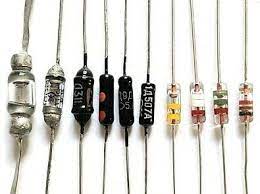What is diode?
 A diode is a semiconductor device that essentially acts as a one-way switch for current. It allows current to flow easily in one direction, but severely restricts current from flowing in the opposite direction. Diodes have polarity, determined by an anode (positive lead) and cathode (negative lead). Most diodes allow current to flow only when positive voltage is applied to the anode. A variety of diode configurations are displayed in this graphic:
A diode is a semiconductor device that essentially acts as a one-way switch for current. It allows current to flow easily in one direction, but severely restricts current from flowing in the opposite direction. Diodes have polarity, determined by an anode (positive lead) and cathode (negative lead). Most diodes allow current to flow only when positive voltage is applied to the anode. A variety of diode configurations are displayed in this graphic:
A diode will block or let current flow, depending on how you connect it in a circuit.
Diodes are essential building blocks in electronic circuits and are widely used in various applications. A standard diode can be used for a range of things, from creating sound effects to power supplies. Diodes are typically made of semiconductor materials, such as silicon or germanium.
Here are some key points about diodes:
-
Forward Bias and Reverse Bias: When a diode is connected with the positive terminal of a power source (anode) to its P-type material and the negative terminal (cathode) to its N-type material, it is said to be forward biased. In this state, the diode allows current to flow easily. Conversely, when the diode is connected in the opposite direction (reverse bias), it acts as an open circuit and blocks the current flow.
-
Current Flow: In forward bias, once the forward voltage (typically around 0.7 volts for silicon diodes) exceeds the diode's forward voltage drop, current can flow from the anode to the cathode. This region of operation is called the "on" state. In reverse bias, only a very small leakage current (known as reverse saturation current) flows due to minority charge carriers.
-
Types of Diodes: There are several types of diodes designed for specific purposes. Some common types include:
- Rectifier Diodes: Used for converting alternating current (AC) to direct current (DC) by rectifying the waveform.
- Zener Diodes: Operate in the reverse breakdown region, allowing precise voltage regulation and protection against voltage spikes.
- Light-Emitting Diodes (LEDs): Emit light when current flows through them, commonly used for indicator lights and displays.
- Schottky Diodes: Have a low forward voltage drop and fast switching characteristics, ideal for high-frequency applications.
- Varactor Diodes: Act as voltage-variable capacitors, used in voltage-controlled oscillators and tuning circuits.
- Avalanche Diodes: Designed to operate in the avalanche breakdown region, used in applications such as voltage clamping and surge protection.
-
Applications: Diodes find extensive use in a wide range of electronic systems. Some common applications include rectification, voltage regulation, signal demodulation, signal switching, current steering, protection circuits, and voltage clamping. They are found in power supplies, radios, televisions, computers, telecommunications equipment, automotive electronics, and many other electronic devices.
Diodes are fundamental components in electronics, allowing the control and manipulation of electrical currents. Their unidirectional current flow characteristics make them essential for various circuit functions, enabling the efficient operation of electronic systems.